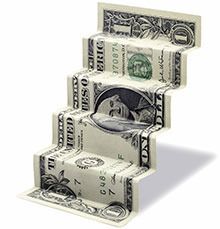Investing in tough ecconomic times – Part I
admin
- 0

The past few years have been the ugliest thing to hit Wall Street in a very long time. We don’t need to tell you….Pick up a newspaper….Turn on the TV….Look at your dwindling account balance.
Some pundits are telling us that this is the end of everything, and the collapse of the entire economy is coming.
Know this: We’ve seen tough times before…many of them. And each and every time, there are those who pronounce the End of Capitalism, and swear up and down that the markets will never come back. Each and every time, they’ve been dead wrong. One of these days, they may be right. Is that time now?
Probably not.
If anything, the present crisis is not sending a message to sell everything and hide, but rather, a message to remain well diversified, and to keep our eyes on the long-term horizon.
“I see this as a time to either buy, sell or hold!” quips Rose Johnson, CFP, an independent investment advisor based in York Harbor, Maine. “Markets go up and down. We can’t predict what the coming months will bring. Nor should we be overly concerned,” she says. “If we’re long-term investors, we build a portfolio that will see us through up times, down times, and flat times.”
The key to building such a portfolio starts with a bit of introspection. “First, you need to have a long-term plan. You need to know why you’re investing, and what you’re investing for,” says Johnson. “Second, you need to select diversified investments that together provide an appropriate level of risk and potential return.”
Know Where You’re Going
Are you saving up for a new car? A new home? Your grandchild’s education? Eventually, of course, you’ll need to build a nest egg to carry you through retirement. How do your future needs match up with the amount you’re currently saving? These are just some of the questions you’ll need to ask yourself while constructing your optimal portfolio.
Perhaps the most important question of all – but one that can only be answered by first tackling the others – is to know your time frame. In other words, when might you need to first pull from your savings? And how much might you need at that point?
“When I help people design portfolios, I first ask them to identify short-term and long-term goals,” says Michael Peters, CFP, a fee-only (takes no commissions) registered investment advisor in Seattle, Washington. “We try to identify future capital expenditures – a home purchase, college tuition, a new car. For most people, the biggest expenditure by far will be getting through the retirement years.”
The need for cash…today, tomorrow, and 20 years from now…is largely what should determine which investments to plug into a portfolio, says Peters.
An Introduction to Asset Allocation
Although the world of investments offers countless opportunities – and dangers! – all investments qualify as either equity, which means something you own (stocks, real estate, gold) or fixed income, which represents money you’ve lent in return for interest (bonds, CDs, money-market funds).
Historically, equity, especially stocks, have provided much greater returns than fixed income investments, but they have also been considerably more volatile. (As we’ve seen of late.) Since 1926, the average annual return of the S&P 500 (an index of large-company U.S. stocks) has clocked in at an impressive 10.4 percent. The average annual return of long-term government bonds, 5.5 percent. But the bond market rarely goes into negative territory, and has never dipped more than 10 percent in a single year. The stock market, in contrast, loses money in almost one of every three years, and this year has lost a lot.
Any good portfolio will have both stocks and bonds. Investment professionals say that these two kinds of investments have “poor correlation.” Poor correlation is a good thing! It means that stocks and bonds tend to perform better at different times. In a year that your stocks are shooting high, your bonds may lag. The next year, stocks may fall, but bonds may rise. (Treasury bond prices, especially, have been on a tear lately.) Having both stocks and bonds in a portfolio smooths out your returns, and helps you sleep better at night.
But what is the best ratio of stocks to bonds to cash…70/25/5?…50/45/5?….30/60/10? That’s where your time frame becomes an essential factor.
“Generally, any money that we might need to tap within the next four years, we want to keep in cash or fixed-income investments, such as bonds” says Peters. “Money that won’t be needed for five or more years, such as money for retirement, if I’m working with 30- or 40-something people, we want primarily in equity, such as stocks.” A typical 35-year-old saving for retirement, for example, might have a “target asset allocation,” or ideal investment mix of about 80 percent stock. A typical 45-year old might want closer to 70 percent.
Peters explains that the money needed in the next four years should be invested so that there is minimal risk to the principal. Beyond four years, taking the added risk of the stock market is usually a fair trade-off for the expected greater return. “But people have very different risk preferences,” adds Peters. “You need to ask yourself how much you’re willing to see your portfolio drop in any one or two year period.”